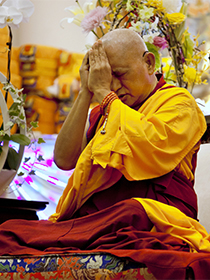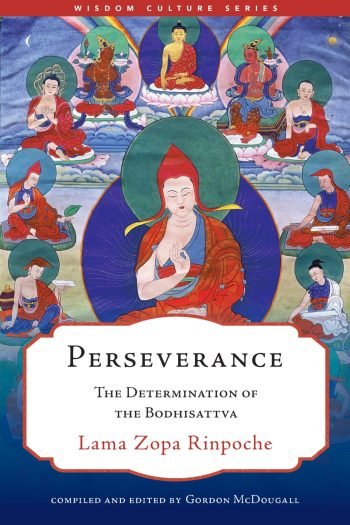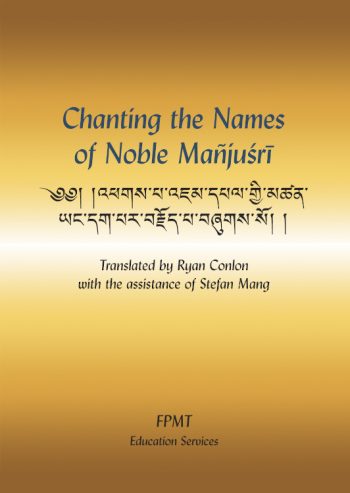- Home
- FPMT Homepage
Foundation for the Preservation of the Mahayana Tradition
The FPMT is an organization devoted to preserving and spreading Mahayana Buddhism worldwide by creating opportunities to listen, reflect, meditate, practice and actualize the unmistaken teachings of the Buddha and based on that experience spreading the Dharma to sentient beings. We provide integrated education through which people’s minds and hearts can be transformed into their highest potential for the benefit of others, inspired by an attitude of universal responsibility and service. We are committed to creating harmonious environments and helping all beings develop their full potential of infinite wisdom and compassion. Our organization is based on the Buddhist tradition of Lama Tsongkhapa of Tibet as taught to us by our founders Lama Thubten Yeshe and Lama Thubten Zopa Rinpoche.
- Willkommen
Die Stiftung zur Erhaltung der Mahayana Tradition (FPMT) ist eine Organisation, die sich weltweit für die Erhaltung und Verbreitung des Mahayana-Buddhismus einsetzt, indem sie Möglichkeiten schafft, den makellosen Lehren des Buddha zuzuhören, über sie zur reflektieren und zu meditieren und auf der Grundlage dieser Erfahrung das Dharma unter den Lebewesen zu verbreiten.
Wir bieten integrierte Schulungswege an, durch denen der Geist und das Herz der Menschen in ihr höchstes Potential verwandelt werden zum Wohl der anderen – inspiriert durch eine Haltung der universellen Verantwortung und dem Wunsch zu dienen. Wir haben uns verpflichtet, harmonische Umgebungen zu schaffen und allen Wesen zu helfen, ihr volles Potenzial unendlicher Weisheit und grenzenlosen Mitgefühls zu verwirklichen.
Unsere Organisation basiert auf der buddhistischen Tradition von Lama Tsongkhapa von Tibet, so wie sie uns von unseren Gründern Lama Thubten Yeshe und Lama Thubten Zopa Rinpoche gelehrt wird.
- Bienvenidos
La Fundación para la preservación de la tradición Mahayana (FPMT) es una organización que se dedica a preservar y difundir el budismo Mahayana en todo el mundo, creando oportunidades para escuchar, reflexionar, meditar, practicar y actualizar las enseñanzas inconfundibles de Buda y en base a esa experiencia difundir el Dharma a los seres.
Proporcionamos una educación integrada a través de la cual las mentes y los corazones de las personas se pueden transformar en su mayor potencial para el beneficio de los demás, inspirados por una actitud de responsabilidad y servicio universales. Estamos comprometidos a crear ambientes armoniosos y ayudar a todos los seres a desarrollar todo su potencial de infinita sabiduría y compasión.
Nuestra organización se basa en la tradición budista de Lama Tsongkhapa del Tíbet como nos lo enseñaron nuestros fundadores Lama Thubten Yeshe y Lama Zopa Rinpoche.
A continuación puede ver una lista de los centros y sus páginas web en su lengua preferida.
- Bienvenue
L’organisation de la FPMT a pour vocation la préservation et la diffusion du bouddhisme du mahayana dans le monde entier. Elle offre l’opportunité d’écouter, de réfléchir, de méditer, de pratiquer et de réaliser les enseignements excellents du Bouddha, pour ensuite transmettre le Dharma à tous les êtres. Nous proposons une formation intégrée grâce à laquelle le cœur et l’esprit de chacun peuvent accomplir leur potentiel le plus élevé pour le bien d’autrui, inspirés par le sens du service et une responsabilité universelle. Nous nous engageons à créer un environnement harmonieux et à aider tous les êtres à épanouir leur potentiel illimité de compassion et de sagesse. Notre organisation s’appuie sur la tradition guéloukpa de Lama Tsongkhapa du Tibet, telle qu’elle a été enseignée par nos fondateurs Lama Thoubtèn Yéshé et Lama Zopa Rinpoché.
Visitez le site de notre Editions Mahayana pour les traductions, conseils et nouvelles du Bureau international en français.
Voici une liste de centres et de leurs sites dans votre langue préférée
- Benvenuto
L’FPMT è un organizzazione il cui scopo è preservare e diffondere il Buddhismo Mahayana nel mondo, creando occasioni di ascolto, riflessione, meditazione e pratica dei perfetti insegnamenti del Buddha, al fine di attualizzare e diffondere il Dharma fra tutti gli esseri senzienti.
Offriamo un’educazione integrata, che può trasformare la mente e i cuori delle persone nel loro massimo potenziale, per il beneficio di tutti gli esseri, ispirati da un’attitudine di responsabilità universale e di servizio.
Il nostro obiettivo è quello di creare contesti armoniosi e aiutare tutti gli esseri a sviluppare in modo completo le proprie potenzialità di infinita saggezza e compassione.
La nostra organizzazione si basa sulla tradizione buddhista di Lama Tsongkhapa del Tibet, così come ci è stata insegnata dai nostri fondatori Lama Thubten Yeshe e Lama Zopa Rinpoche.
Di seguito potete trovare un elenco dei centri e dei loro siti nella lingua da voi prescelta.
- 欢迎 / 歡迎
简体中文
“护持大乘法脉基金会”( 英文简称:FPMT。全名:Foundation for the Preservation of the Mahayana Tradition) 是一个致力于护持和弘扬大乘佛法的国际佛教组织。我们提供听闻,思维,禅修,修行和实证佛陀无误教法的机会,以便让一切众生都能够享受佛法的指引和滋润。
我们全力创造和谐融洽的环境, 为人们提供解行并重的完整佛法教育,以便启发内在的环宇悲心及责任心,并开发内心所蕴藏的巨大潜能 — 无限的智慧与悲心 — 以便利益和服务一切有情。
FPMT的创办人是图腾耶喜喇嘛和喇嘛梭巴仁波切。我们所修习的是由两位上师所教导的,西藏喀巴大师的佛法传承。
繁體中文
護持大乘法脈基金會”( 英文簡稱:FPMT。全名:Found
ation for the Preservation of the Mahayana Tradition ) 是一個致力於護持和弘揚大乘佛法的國際佛教組織。我們提供聽聞, 思維,禪修,修行和實證佛陀無誤教法的機會,以便讓一切眾生都能 夠享受佛法的指引和滋潤。 我們全力創造和諧融洽的環境,
為人們提供解行並重的完整佛法教育,以便啟發內在的環宇悲心及責 任心,並開發內心所蘊藏的巨大潛能 — 無限的智慧與悲心 – – 以便利益和服務一切有情。 FPMT的創辦人是圖騰耶喜喇嘛和喇嘛梭巴仁波切。
我們所修習的是由兩位上師所教導的,西藏喀巴大師的佛法傳承。 察看道场信息:
- FPMT Homepage
- News/Media
-
- Study & Practice
-
-
- About FPMT Education Services
- Latest News
- Programs
- New to Buddhism?
- Buddhist Mind Science: Activating Your Potential
- Heart Advice for Death and Dying
- Discovering Buddhism
- Living in the Path
- Exploring Buddhism
- FPMT Basic Program
- FPMT Masters Program
- FPMT In-Depth Meditation Training
- Maitripa College
- Lotsawa Rinchen Zangpo Translator Program
- Universal Education for Compassion & Wisdom
- Online Learning Center
-
- Prayers & Practice Materials
- Overview of Prayers & Practices
- Full Catalogue of Prayers & Practice Materials
- Explore Popular Topics
- Benefiting Animals
- Chenrezig Resources
- Death & Dying Resources
- Lama Chopa (Guru Puja)
- Lama Zopa Rinpoche: Compendium of Precious Instructions
- Lama Zopa Rinpoche: Life Practice Advice
- Lama Zopa Rinpoche Practice Series
- Lamrim Resources
- Mantras
- Prayer Book Updates
- Purification Practices
- Sutras
- Thought Transformation (Lojong)
- Audio Materials
- Dharma Dates - Tibetan Calendar
- Translation Services
- Publishing Services
- Ways to Offer Support
- Prayers & Practice Materials
-
- Teachings and Advice
- Find Teachings and Advice
- Lama Zopa Rinpoche Advice Page
- Lama Zopa Rinpoche: Compendium of Precious Instructions
- Lama Zopa Rinpoche Video Teachings
- ༧སྐྱབས་རྗེ་བཟོད་པ་རིན་པོ་ཆེ་མཆོག་ནས་སྩལ་བའི་བཀའ་སློབ་བརྙན་འཕྲིན།
- Podcasts
- Lama Yeshe Wisdom Archive
- Buddhism FAQ
- Dharma for Young People
- Resources on Holy Objects
- Teachings and Advice
-
-
*If a menu item has a submenu clicking once will expand the menu clicking twice will open the page.
-
-
- Centers
-
- Teachers
-
- Projects
-
-
-
-
*If a menu item has a submenu clicking once will expand the menu clicking twice will open the page.
-
-
- FPMT
-
-
-
-
-
When ordinary people die they are out of control. Because they have not trained themselves during their life, they are overwhelmed by the experience of death and bewildered as their bodily elements go out of balance and cease to function harmoniously.
Lama Thubten Yeshe
-
-
-
- Shop
-
-
-
The Foundation Store is FPMT’s online shop and features a vast selection of Buddhist study and practice materials written or recommended by our lineage gurus. These items include homestudy programs, prayers and practices in PDF or eBook format, materials for children, and other resources to support practitioners.
Items displayed in the shop are made available for Dharma practice and educational purposes, and never for the purpose of profiting from their sale. Please read FPMT Foundation Store Policy Regarding Dharma Items for more information.
-
-
Lama Zopa Rinpoche News and Advice
5

Lama Zopa Rinpoche in Nepal, March 27, 2023. Photo by Ven. Lobsang Sherab.
April 13, 2024 marks the one-year anniversary of Lama Zopa Rinpoche showing the aspect of passing away.
As a reminder to students, Advice for the Anniversary of the Guru’s Passing Away is a short text translated by Rinpoche that explains the importance of making offerings on the anniversary of the passing away of one’s guru. It sets out the benefits of making offerings, how to make the offerings with six remembrances, and how to offer and dedicate the roots of virtue collected. Rinpoche specifically wanted to translate this text for the anniversary of Lama Yeshe’s passing, and it was a text that he wanted available for quite some time. We mention this to emphasize how important Rinpoche felt it was to offer these practices on the anniversary of the guru’s passing, for example, doing Lama Chopa and Tsog Offering as Rinpoche said in the Foreword.
A commemoration will occur at Kopan Monastery on April 13, where they will offer Heruka Lama Chopa and Tsog Offering puja, Chanting the Names of Noble Manjushri, and other prayers. The puja is being sponsored by FPMT International Office on behalf of the entire FPMT organization. Kopan Monastery reports that this puja will be livestreamed, those interested in joining should pay attention to the Kopan Facebook page for this, and we will also share this information once we have it.
These prayers and practices are available to download here:
In addition to the commemoration, on April 12th, Senior Sangha members and FPMT students will engage Yamantaka self-initiation; and on April 14th, Rinpoche’s students and Sangha members from various centers and organizations will gather for Vajrayogini self-initiation.
As Rinpoche explains in the foreword of the text, Advice for the Anniversary of the Guru’s Passing Away, “Making offerings on the death anniversary of a guru is an incredible practice in that it brings about the greatest purification of negative karma and collects the most extensive merit.”
28
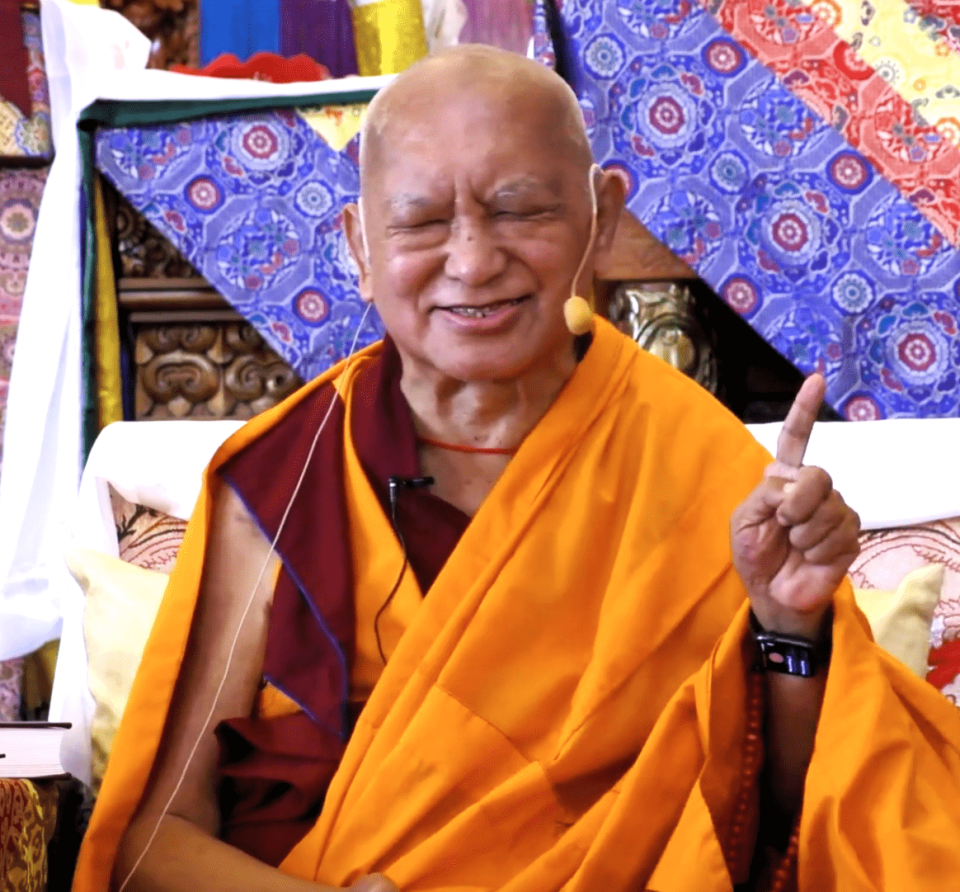
Lama Zopa Rinpoche teaching at Kopan Monastery, April 8, 2023.
Lama Zopa Rinpoche offered four teachings at Kopan Monastery on April 7, 8, and 9 before leaving for Tsum Valley on April 10. As we now all know, Rinpoche showed the aspect of passing away on April 13, and as such, these teachings are particularly precious as they are the last organized and recorded teachings Rinpoche offered in this life.
Today we are sharing advice that was offered by Rinpoche on April 9 during his longer teaching, and excerpted in two parts for inclusion in our 2023 Annual Review. This essential, clear advice is particularly meaningful to those offering service within the FPMT organization.
The One Answer is to Practice Lamrim
If you want to make your life really fruitful, really meaningful, the one answer is to practice lamrim. Otherwise, your life is spent in hallucination. There are many different levels of hallucination. Your life is spent in distraction, with attachment and anger, but especially with attachment. Like that, your life is spent in hallucination. …
Even if you’re working, even if you have to do a job to make money, your motivation should be to benefit sentient beings, to serve sentient beings. Do you understand?
You should be humble and respectful with your body, speech, and mind. You should be kind to everyone, even those who criticize or harm you. You should be kind, polite, and serve others with your body and speech.
It makes people so happy when you speak politely to them. With holy objects, you have a mind of devotion, but with sentient beings, you should have compassion.
The Quickest Way to Enlightenment
The guru is more precious than Buddha Vajradhara.
The guru is the creator, the doer, who manifests the numberless buddhas. This is mentioned in the tantric teachings. When you receive teachings in the future from someone with whom you have a guru-disciple relationship, this is the meditation that you should do. You are receiving the teaching or initiation from all the buddhas. You are also receiving it from your special deity. Do you understand?
You have to have that understanding. It is so precious, so precious, so precious. It is similar when you are making offerings or offering service. You are making offering or offering service to the one who is more special than all the buddhas, more special than even your own deity.
You have to keep all that in your mind; you have to keep it in your diarrhea book [Rinpoche often jokingly referred to a students’ Dharma journal for notes, quotations, and teachings as their “diarrhea book”]. I have just mentioned the essence of the practice of guru yoga. It is mentioned very clearly in the long Six-Session Yoga. Even if you are offering a meal, tea, water, or a candy, since the numberless atoms of the guru’s holy body are all the buddhas, it means you are offering to numberless buddhas.
Even in each atom there are numberless buddhas. Whatever it is—you’re offering service, receiving teachings or advice or a scolding—it is all the buddhas; it comes from all the buddhas, so, from your mind-seal deity.
So, that is the guru yoga practice, and that is the reality.
Through that, you then receive the blessings of the guru; then through that, you achieve enlightenment.
Okay, thank you. Thank you very much. I’m not advertising that I’m buddha. I’m not saying that.
Generally, this is how you should think in the future, okay. Yes, for you, your guru is more precious than the numberless buddhas, more precious than your own deity. That is so important.
Think this with everything: with every offering and offering of service, with receiving advice. It’s so important. You then collect the highest merit and experience the greatest purification. Do you understand?
This is the quick way to achieve enlightenment.
Transcribed and subsequently edited by Ven. Ailsa Cameron from the audio recording of Lama Zopa Rinpoche’s April 9, 2023 teaching at Kopan Monastery. Excerpted for inclusion in the 2023 Annual Review by FPMT International Office.
Lama Zopa Rinpoche (1945-2023) was the spiritual director of the Foundation for the Preservation of Mahayana Tradition (FPMT), a Tibetan Buddhist organization dedicated to the transmission of the Mahayana Buddhist tradition and values worldwide through teaching, meditation and community service.
27
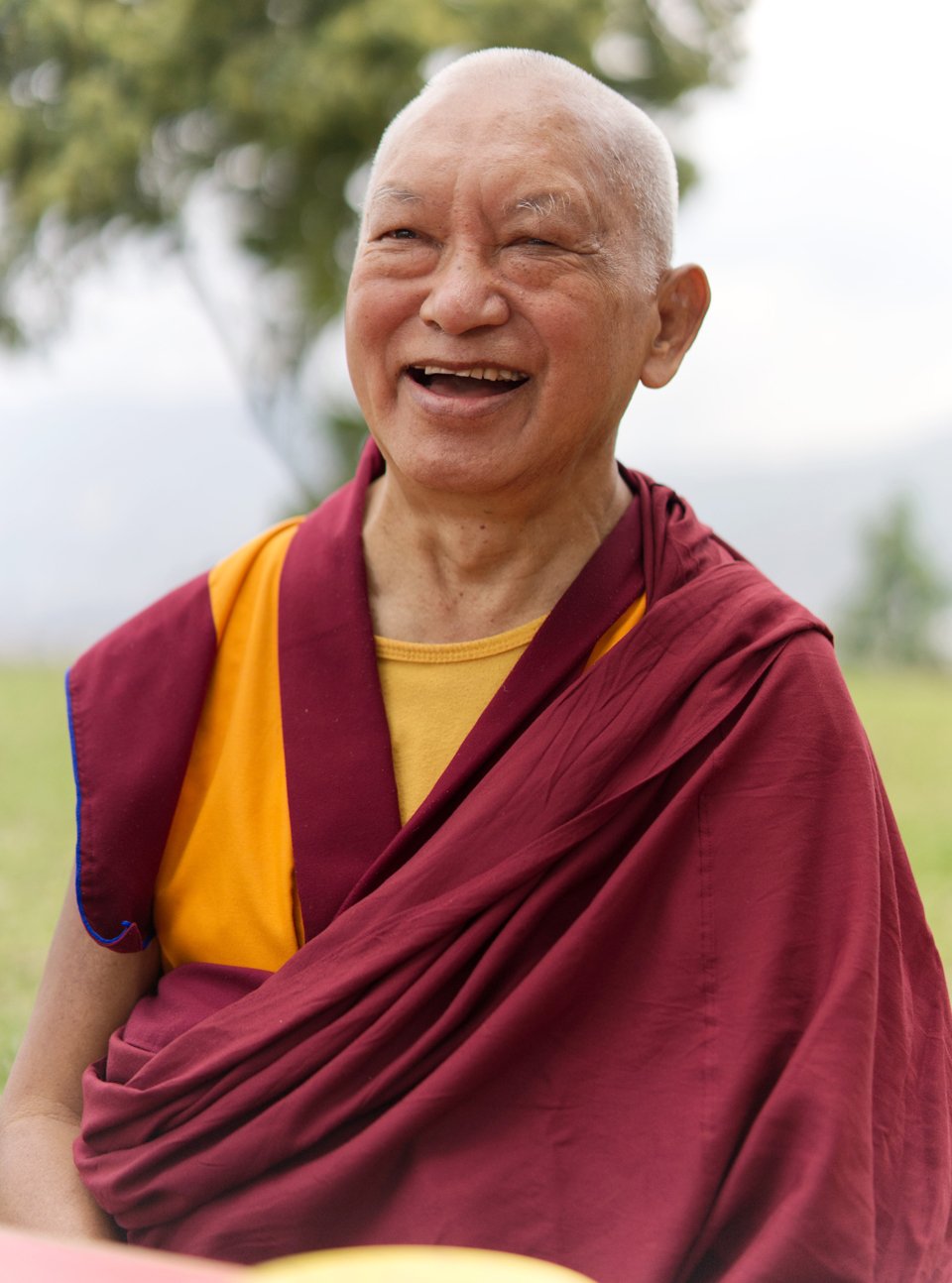
Lama Zopa Rinpoche on top of Kopan Hill, Kopan Monastery, Nepal, May 2020. Photo by Ven. Lobsang Sherab.
We recently shared news that Lama Zopa Rinpoche’s newest volume from Wisdom Publications, Perseverance: The Determination of the Bodhisattva is available.
Today we offer you a chapter from this book made available from Wisdom titled “Overcoming Laziness.” In this transformative chapter, Rinpoche offers invaluable insights and practical guidance on how to overcome laziness, which he explains is the greatest obstacle to happiness.
The Three Types of Laziness
Laziness, the antithesis of perseverance, is the devil that most interferes with transforming the mind and, therefore, it is the greatest obstacle to happiness. There are three types of laziness:
1. The laziness of procrastination
2. The laziness of being attached to worldly affairs
3. The laziness of discouragement
Of this Shantideva says,
7.2b And what are the adversaries of fortitude?
They are indolence, a fondness for evil, and despondency and self-deprecation.
The first laziness, the laziness of procrastination or indolence, blocks our energy for Dharma practice and causes us to waste time with distractions. This kind of laziness comes about as a result of lacking the understanding of the nature of samsara, the cause of suffering, and the evolution of karma. The second type, being attached to worldly affairs, is the worst form of laziness, the laziness that draws us to engage in negative actions of greed, ignorance, and hatred—actions that are the opposite of Dharma practice. The third type of laziness, discouragement or despondency, causes us to not do positive things with the excuse that we are unable to do them. This is the mind that thinks, “It’s beyond my capabilities.” The less lazy we are, the fewer hindrances to meditation we will experience.
Spending all day and all night working for samsaric comforts is considered laziness from the Dharma point of view. Because we don’t remember our past sufferings or know those that lie ahead, we work hard for ignorance and greed; we are lazy in that way.
Milarepa said that by having generated impermanence, he was able to conquer “the devil, laziness,” and then whatever action he did became the Dharma. Highly realized beings, such as Lama Tsongkhapa, are utterly without laziness. Without talking about all the other unimaginable great actions they do, because of their bodhichitta, even just breathing becomes great work for other sentient beings.
Continue reading Lama Zopa Rinpoche’s full chapter on “Overcoming Laziness.”
Learn more about Perseverance: The Determination of the Bodhisattva from Wisdom Publications and order your copy today:
wisdomexperience.org/product/perseverance
Lama Zopa Rinpoche (1945-2023) was the spiritual director of the Foundation for the Preservation of Mahayana Tradition (FPMT), a Tibetan Buddhist organization dedicated to the transmission of the Mahayana Buddhist tradition and values worldwide through teaching, meditation and community service.
21
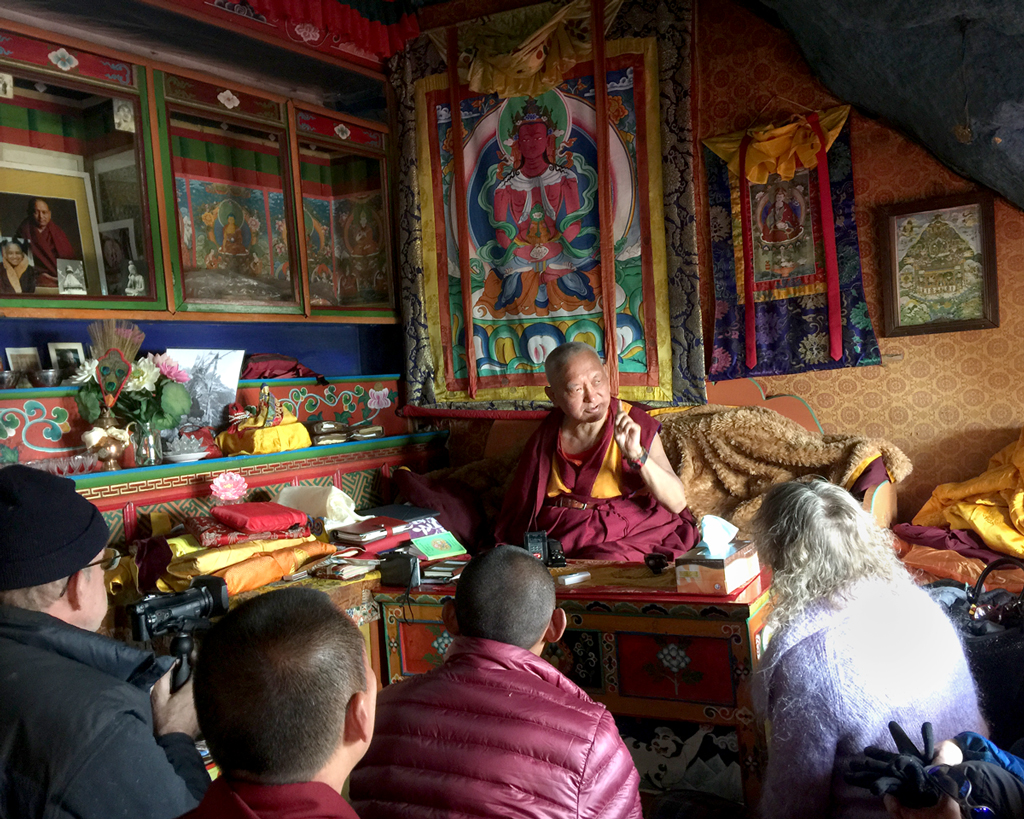
Lama Zopa Rinpoche talking about the previous Lawudo Lama in his meditation cave, Lawudo, Solu Khumbu, Nepal, April 2015. Photo by Ven. Roger Kunsang.
In a talk given to a few students in the Lawudo cave in 2015, Lama Zopa Rinpoche shared details of his early life. The Lawudo cave is the location where Rinpoche, in his past life as the Lawudo Lama Kunsang Yeshe, spent the last 30 years of his life in intensive meditation retreat. Rinpoche also shares some information about this holy cave.
We invite you to watch this joyful and intimate video, filmed by Bill Kane:
As a reminder, the anniversary of Rinpoche showing the aspect of passing away is approaching on April 13. You can find resources for observing this special date, and learn more about the commemoration activities being offered at Kopan Monastery during this time.
You can read a moving eulogy of Rinpoche’s life, which also shares details of his early life and connection to Lawudo.
The Lawudo Lama by Jamyang Wangmo tells the story the Lawudo Lama Kunzang Yeshe as well as offers a detailed description of the religious and cultural history of the Mount Everest region, where Lawudo is situated.
Lama Zopa Rinpoche (1945-2023) was the spiritual director of the Foundation for the Preservation of Mahayana Tradition (FPMT), a Tibetan Buddhist organization dedicated to the transmission of the Mahayana Buddhist tradition and values worldwide through teaching, meditation and community service.
- Tagged: lama zopa rinpoche, lawudo, lawudo lama, lawudo retreat centre
18
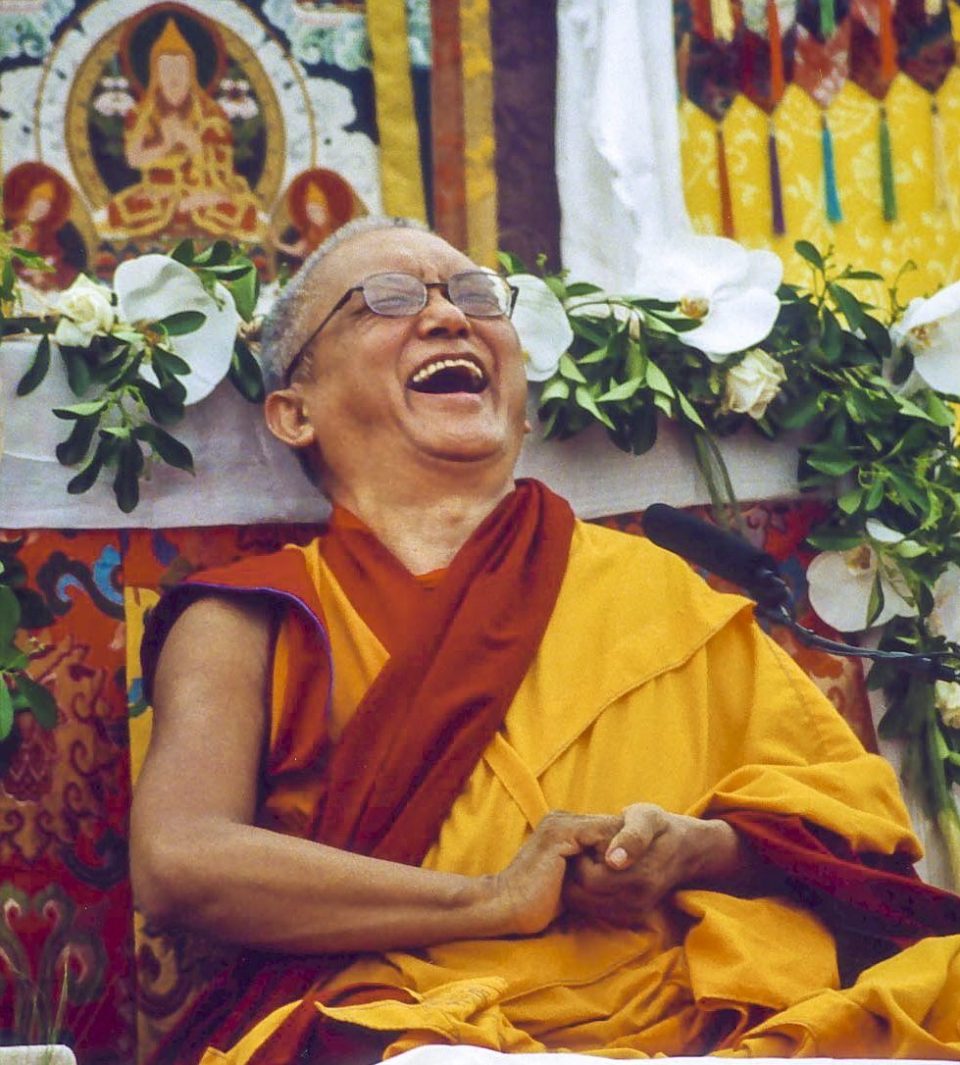
Lama Zopa Rinpoche teaching at the 4 Kadampa Deities Retreat, Institut Vajra Yogini, France, 2003. Photo by Ven. Kunsang Thubten.
Recently we shared the addition to our Rinpoche Available Now page of Lama Zopa Rinpoche’s 2003 twenty-three part teachings from a Four Kadampa Deities Retreat offered at Institut Vajra Yogini, France. The retreat focused on the four Kadampa deities, however, Rinpoche taught on a broad range of lamrim topics.
Today we wanted to bring to your attention teaching #5 in this series, “Enlightenment through Compassion.”
In this teaching, Rinpoche began by discussing the importance of helping young people and expresses a sense of urgency for Universal Education as a method that can bring peace to individuals and the world, regardless of their religious background. By fostering compassion, wisdom, and good conduct, individuals can bring peace not only to themselves and their families but also to their countries, the world, and all sentient beings.
Rinpoche discussed the power of generating compassion toward even a single sentient being by sharing the story of Getsul Tsembulwa, a disciple of the great yogi Nakpo Chopawa, encountering a woman with leprosy who needed help crossing a river. This story shows how compassion toward even one sentient being can lead to enlightenment. The stronger the compassion, the quicker the path to enlightenment becomes. By giving up one’s life and sacrificing for the welfare of another, heavy negative karma is purified, allowing one to see the true nature of the deity. Generating compassion toward even one sentient being can make that being the most kind and precious person in one’s life. Generating compassion leads to bodhichitta, which is the root of the Mahayana path of enlightenment. Once enlightened, one can liberate countless sentient beings from samsaric suffering and bring them to enlightenment, thus continuously benefiting others.
Rinpoche stressed that it is important to practice holy Dharma throughout life, as death is certain and only holy Dharma can guide one at that crucial moment. Rinpoche advises keeping the mind in the lamrim, the stages of the path to enlightenment, and engaging in virtuous actions aligned with the teachings. By doing so, every aspect of life becomes meaningful and contributes to one’s progress toward liberation and enlightenment.
At the end of Rinpoche’s talk, he delves into meditation on emptiness.
We invite you to watch this full video and engage with a lightly edited version of this teaching which is available from the Lama Yeshe Wisdom Archive.
As a reminder, this entire retreat is now available for students to explore as they wish.
Foundation for the Preservation of Mahayana Tradition (FPMT), is a Tibetan Buddhist organization dedicated to the transmission of the Mahayana Buddhist tradition and values worldwide through teaching, meditation and community service.
8
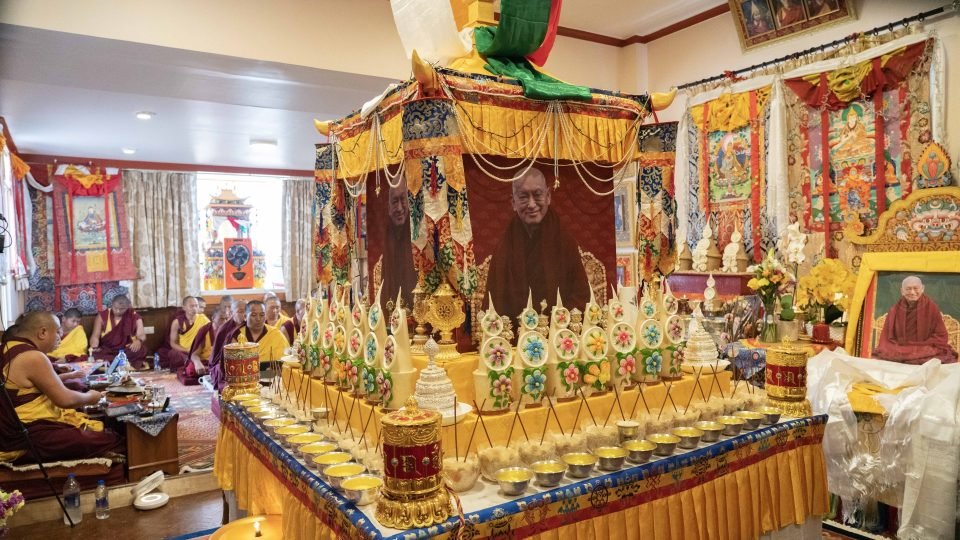
Sangha offering prayers in front of Lama Zopa Rinpoche’s holy body, April 21, 2023. Photo by Ven. Lobsang Sherab.
April 13, 2024 marks the one-year anniversary of Lama Zopa Rinpoche showing the aspect of passing away.
We want to remind students about a text translated by Rinpoche, Advice for the Anniversary of the Guru’s Passing Away which is a short text that explains the importance of making offerings on the anniversary of the passing away of one’s guru. It sets out the benefits of making offerings, how to make the offerings with six remembrances, and how to offer and dedicate the roots of virtue collected.
As Rinpoche explains in the foreword of this text, “Making offerings on the death anniversary of a guru is an incredible practice in that it brings about the greatest purification of negative karma and collects the most extensive merit.”
There are six benefits of making offerings on the anniversary of your guru’s passing away. The Hundred Clear Realizations of the Glorious One from Narthang offers the great Kadampa geshe Sharawa’s citation from Guhyasamaja and Vairochana’s Net of Magical Illusion:
- You complete your guru’s holy wishes.
- You purify the negative karmas and obscurations collected in dependence on the guru.
- You achieve extensive merits.
- In future lives, you meet gurus.
- You become an object to be subdued by gurus.
- You quickly cease your samsara.
On March 10, 2021, Rinpoche gave commentary on these points during a teaching from Kopan Monastery, and you can read that commentary starting on page 13 of this full transcript.
A commemoration will occur at Kopan Monastery on April 13. Following the commemoration, Kopan is also hosting a Heart Sutra Retreat (April 15-20). His Eminence the 104th Ganden Tripa Rinpoche will offer commentary during the retreat and Ven. Steve Carlier will lead meditations. There are still spots available for this retreat, and you can contact Kopan Monastery for more information. We will share more details about this commemoration closer to the date.
Another auspicious opportunity relating to Lama Zopa Rinpoche we’d like to remind about is the Lawudo Pilgrimage happening from April 25-May 9. This is a pilgrimage for students of Rinpoche honoring him as the Lawudo Lama by visiting the main holy places of the area with prayers and practices for Rinpoche’s swift return. There are still spots available in this pilgrimage as well.
Lama Zopa Rinpoche (1945-2023) was the spiritual director of the Foundation for the Preservation of Mahayana Tradition (FPMT), a Tibetan Buddhist organization dedicated to the transmission of the Mahayana Buddhist tradition and values worldwide through teaching, meditation and community service.
- Tagged: anniversary of the guru passing
1
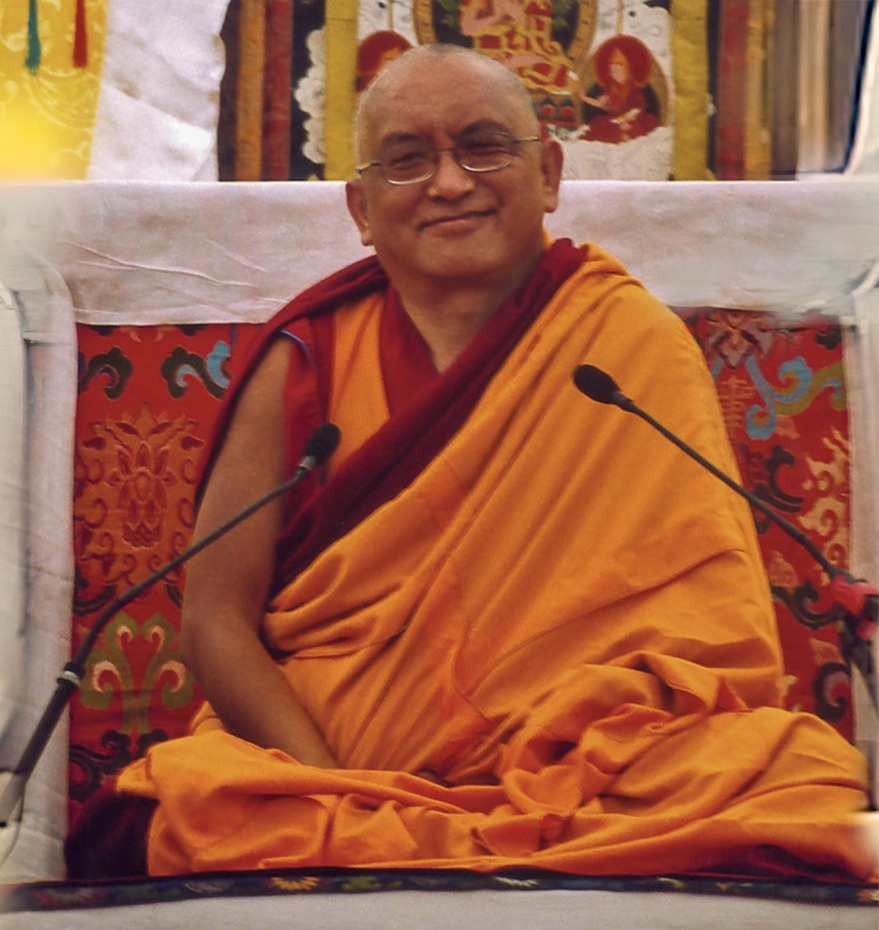
Lama Zopa Rinpoche teaching during the Four Kadampa Deities Reteat, Institut Vajra Yogini, France, 2003.
From April 18 to May 11, 2003 Lama Zopa Rinpoche gave extensive teachings (twenty-three videos!) during the Four Kadampa Deities Retreat at Institut Vajra Yogini, France. The retreat focused on the four Kadampa deities, however, Rinpoche teaches on a broad range of lamrim topics. Each of the videos on YouTube includes summaries of the main topics discussed by Rinpoche.
We are so pleased to announce today that this entire retreat is now available on our Rinpoche Available Now page!
As we work to process all of the legacy videos of Rinpoche’s teachings, we rejoice that this is the first major retreat finished! We have many more videos coming up and we hope students will take full advantage of connecting with Rinpoche’s previously unavailable videos in this way.
The Lama Yeshe Wisdom Archive previously published the contents of this retreat as well, and you are welcome to read the lightly edited teachings there. You can also find a full transcript of this event for download.
Lama Zopa Rinpoche (1945-2023) was the spiritual director of the Foundation for the Preservation of Mahayana Tradition (FPMT), a Tibetan Buddhist organization dedicated to the transmission of the Mahayana Buddhist tradition and values worldwide through teaching, meditation and community service.
27
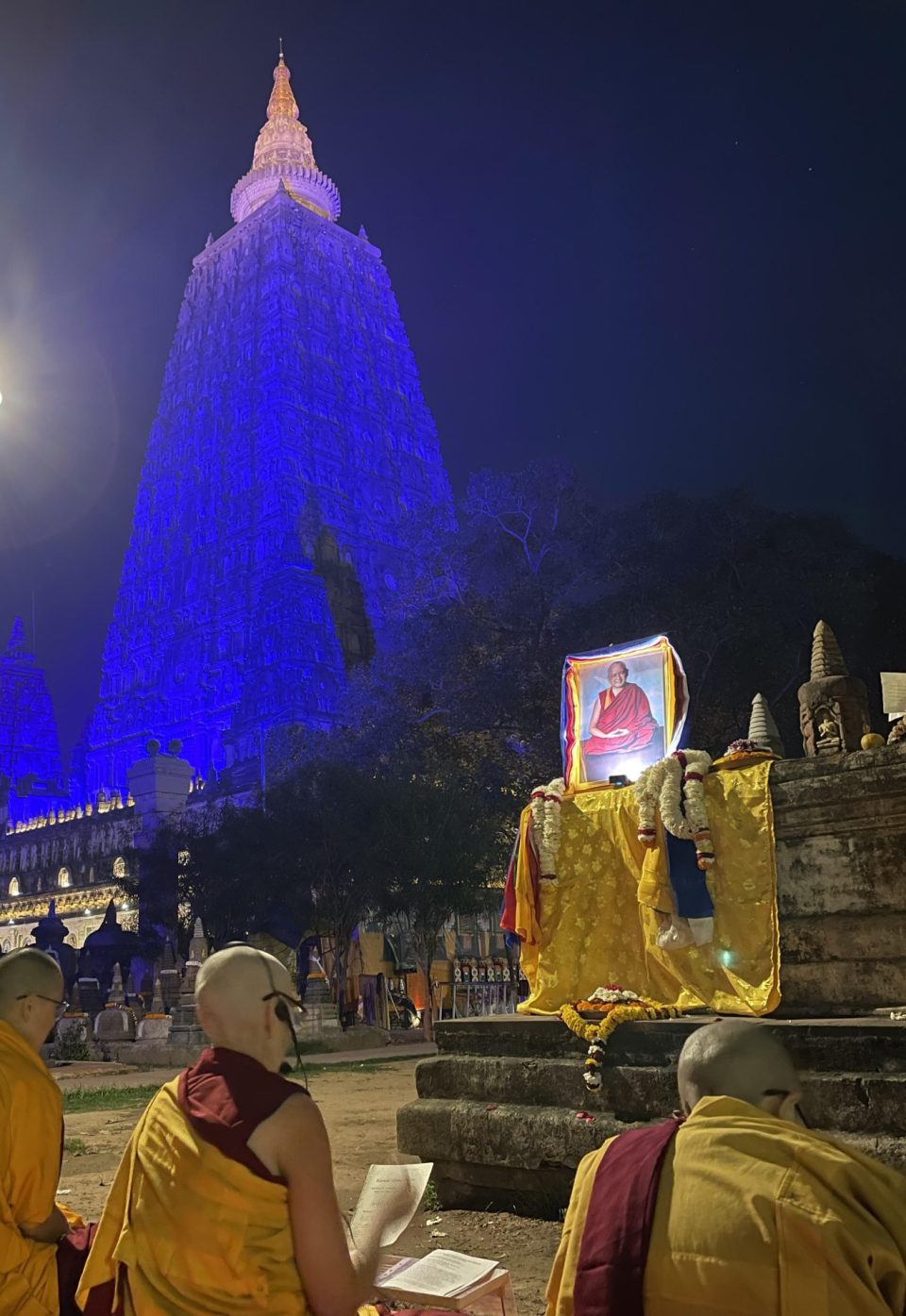
Livestream of the prayers for Rinpoche’s swift return with the stupa and bodhi tree lit up and changing color in the distance. Photo by Tukba Akil.
We share this moving account from Ven. Sarah Thresher about the prayers offered for Lama Zopa Rinpoche’s swift return during the Fifteen Days of Miracles in Bodhgaya, India.
It’s common to hear chanting at the great place of enlightenment in Bodhgaya; groups travel thousands of miles to pray together at the stupa in Pali and Tibetan. It’s far less common to hear prayers chanted in English—and it certainly turns heads when that happens and is noticed by the many pilgrims from around the world.
It wasn’t till the second or third day of our fifteen days of prayers for Rinpoche’s swift return at the place of enlightenment during the miracle days that I realized this simple fact: coming together and chanting prayers together in English was itself a powerful way to repay the kindness of our precious spiritual guide Lama Zopa Rinpoche. There we were sitting together under the bodhi tree, three nuns—English, Chinese and Indian—along with a small but dedicated team of students from around the world praying together in English—the very language Rinpoche had used to teach us and lead us in prayers and practices; the language Rinpoche had learned from a young age in order to spread the Buddha’s teachings in this world. That simple act was proof of Rinpoche’s unfathomable kindness and achievement and greatness.
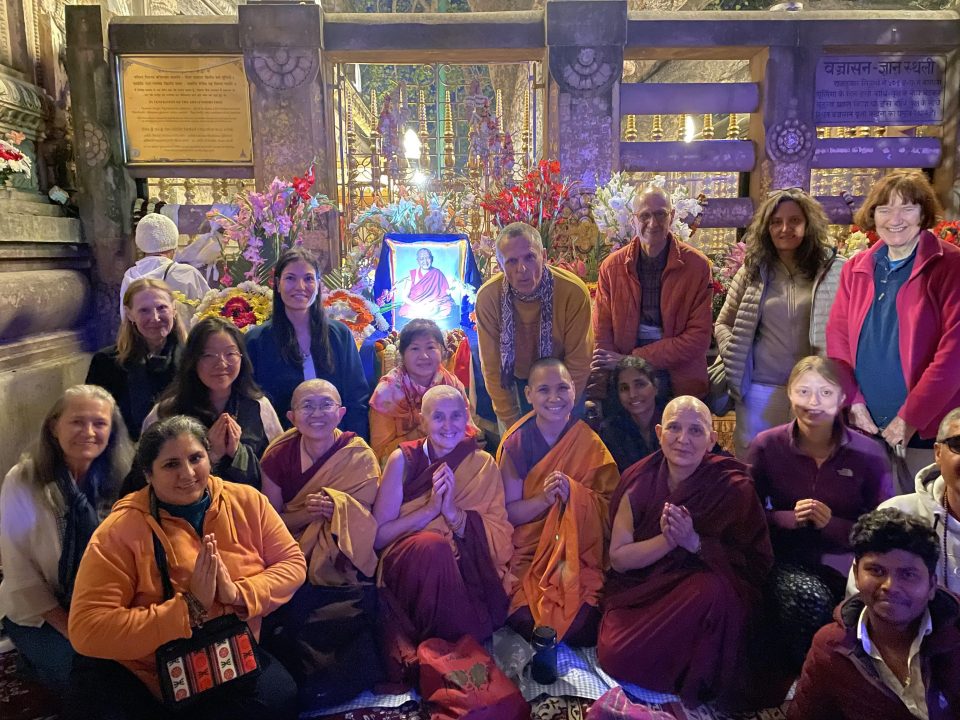
Group photo on the final evening of prayers—Chotrul Duchen. Photo by Pratyaksh Sehrawat.
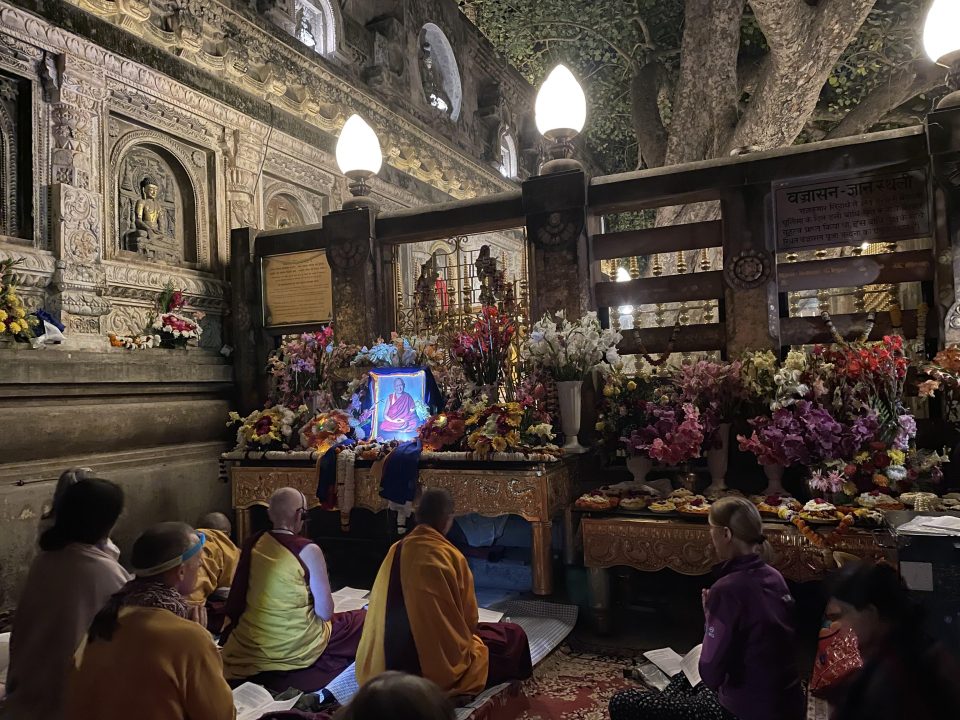
Prayers underneath the bodhi tree at the seat of enlightenment. Photo by Tukba Akil.
All the Buddha merit increasing days are special at Root Institute because it’s a time when many offerings and prayers are made for the incredibly kind sponsors of the Festival of Lights and Merits (FLAM) and of Rinpoche’s projects in Bodhgaya. But this year it was decided to add a special prayer session every evening at the stupa with a selection of prayers either recommended by Rinpoche for the merit increasing days or advised by His Holiness and other holy beings to be recited for Rinpoche’s swift return. We were fortunate to get permission from the Temple management to reserve a place and to livestream the prayers for all fifteen days. We chose to sit under the bodhi tree right next to the only ancient Manjushri image in the stupa precincts—though some days we sat back amongst the smaller stupas so that people could see the stupa and bodhi tree spectacularly lit up and changing color as the prayer session unfolded.
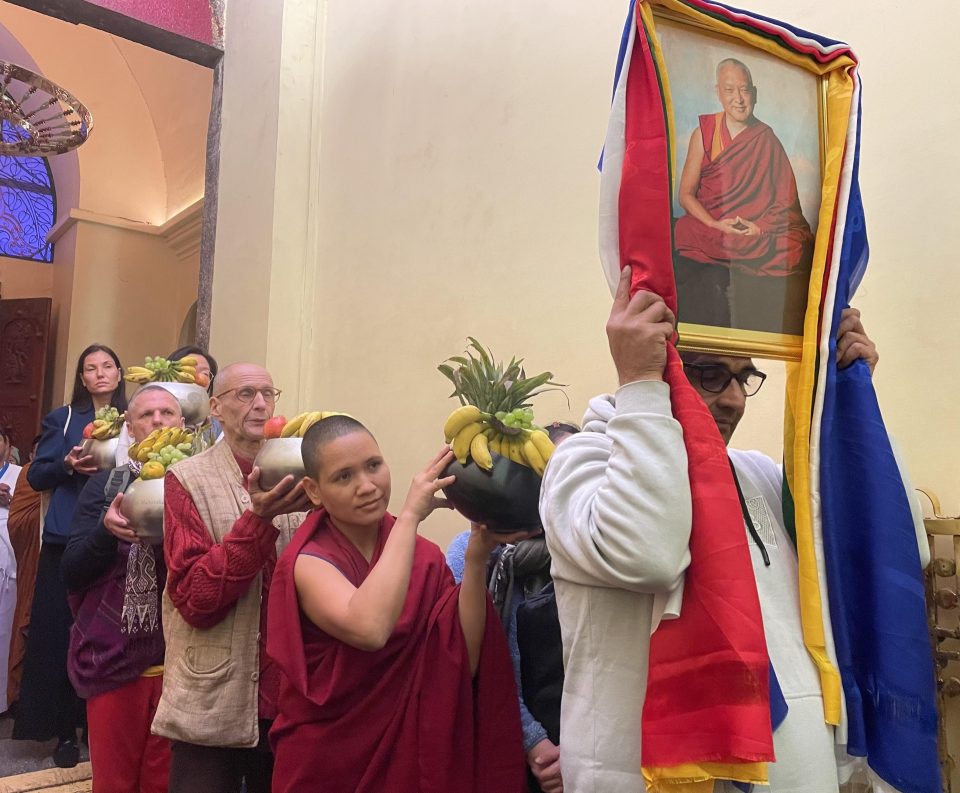
A procession of students led by Rinpoche offering bowls of fruit to the main image of Shakyamuni Buddha in the temple. Photo by Ven. Sarah Thresher.
Two nights it rained but we still showed up. Two nights we added extensive offerings of bowls of fruit in procession to the Buddha image following the prayers—something Ven. Roger sponsored as he mentioned it was what Rinpoche liked to do. On the penultimate evening, a monk came up towards the end of the prayers and asked if he could offer a khata to Rinpoche—many people would pay respect, show approval and request blessing when they saw Rinpoche’s photo. We of course happily agreed, only to find out that it was actually H.E. Avikrita Vajra Sakya who had sent the monk to ask and he along with his entourage then approached to offer khatas to Rinpoche’s photo. “That’s Manjushri offering to Rinpoche,” I said, feeling very moved by the gesture. It was as though the Buddhas themselves were acknowledging the prayers and heartfelt longing of us disciples for the return of our precious Lama and offering comfort.

Ven. Dekyong from Singapore, Ven. Sarah from England and Ven. Anshu from India who led the prayers. Photo by Nick Redmond.
Ven. Sarah Thresher is an English nun who graduated in 1982 and met the Dharma in Kopan shortly afterwards—taking refuge with Lama Thubten Yeshe. She worked many years as an editor for Wisdom Publications and Lama Yeshe Wisdom Archive and has also taught at centers around the world. She ordained with His Holiness Dalai Lama in 1986. For the past five years she has been living in different locations in Nepal.
Please read about His Holiness the Dalai Lama’s advice for reciting Chanting the Names of Noble Manjushri for Lama Zopa Rinpoche’s swift return.
Lama Zopa Rinpoche (1945-2023) was the spiritual director of the Foundation for the Preservation of Mahayana Tradition (FPMT), a Tibetan Buddhist organization dedicated to the transmission of the Mahayana Buddhist tradition and values worldwide through teaching, meditation and community service.
- Tagged: bodhgaya, fifteen days of miracles
7
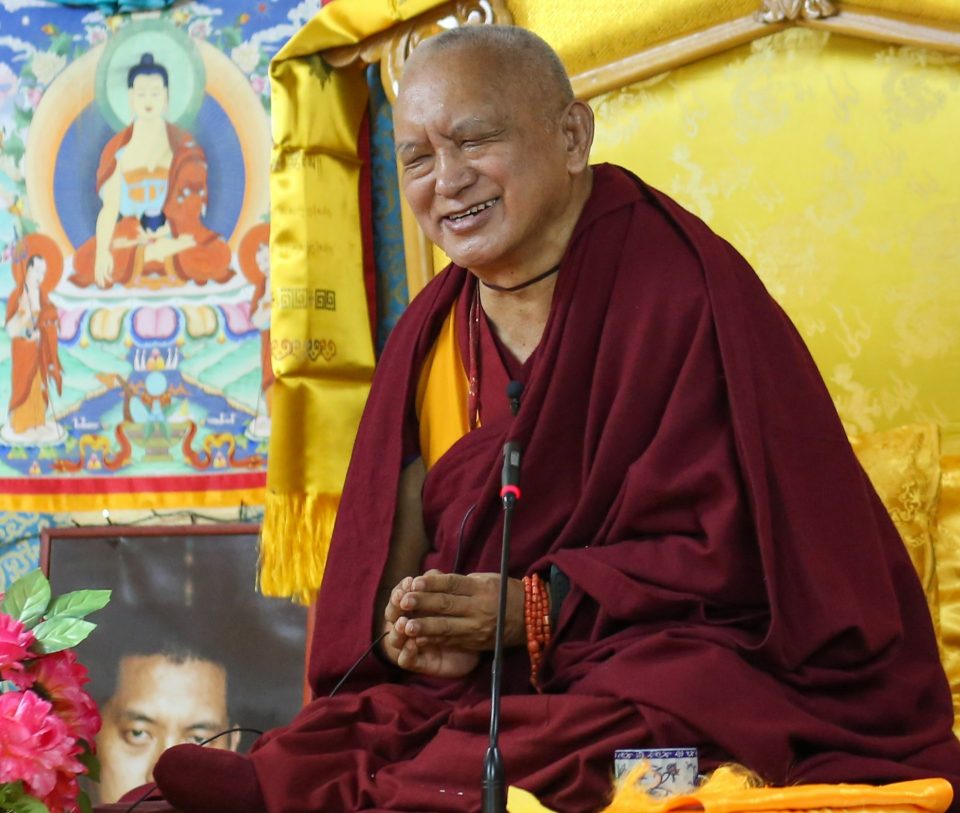
Lama Zopa Rinpoche offering advice to the students in Mongolia, September 2013. Photo by Ven. Thubten Kunsang
Lama Zopa Rinpoche received thousands of letters every year from people seeking guidance on a variety of issues. In 2013 Rinpoche dictated a letter about the three types of suffering to a student’s mother who was worried about death.
“In reality, even if we believe that we will live for a long time, that we have so many years to live – like 100 years or more, and maybe after 100 years, we expect another hundred years (I’m joking) – in reality, there is nobody who has lived who has not died,” Rinpoche wrote.
“Even this big earth has to perish after another great eon. Since every person who is born in this world is under the control of karma and delusion, there is nobody, nobody, since human beings started until now, who has lived without death. There is nobody.
“Buddha has no death, because there is no cause of death. The cause of death is not outside but inside –karma and delusions. Buddha removed this inconceivable eons ago, because he purified the delusions and even the subtle obscurations which interrupt the omniscient mind, so it is impossible for the Buddha to experience death. There is no old age, no sickness, no death for him at all, but he showed holy deeds, passing away in the sorrowless state. If Buddha did not show death, then we would not appreciate his teachings and we would become very lazy. Buddha showed death to destroy the wrong concept of permanence of our lives, which are impermanent, and also to show us that we need to practice Dharma, because of suffering and the cause of suffering. …”
You can read the entire letter “The Cause of Death” on the Lama Yeshe Wisdom Archive website.
FPMT.org makes available many practices and resources available for the death and dying of ourselves and our loved ones (and pets!). All are welcome to explore all that is available, collected and compiled over time according to the advice of Lama Zopa Rinpoche:
fpmt.org/death
Please explore more recent teachings from Lama Zopa Rinpoche on death and impermanence:
fpmt.org/tag/death-and-dying
Lama Zopa Rinpoche (1945-2023) was the spiritual director of the Foundation for the Preservation of Mahayana Tradition (FPMT), a Tibetan Buddhist organization dedicated to the transmission of the Mahayana Buddhist tradition and values worldwide through teaching, meditation and community service.
5
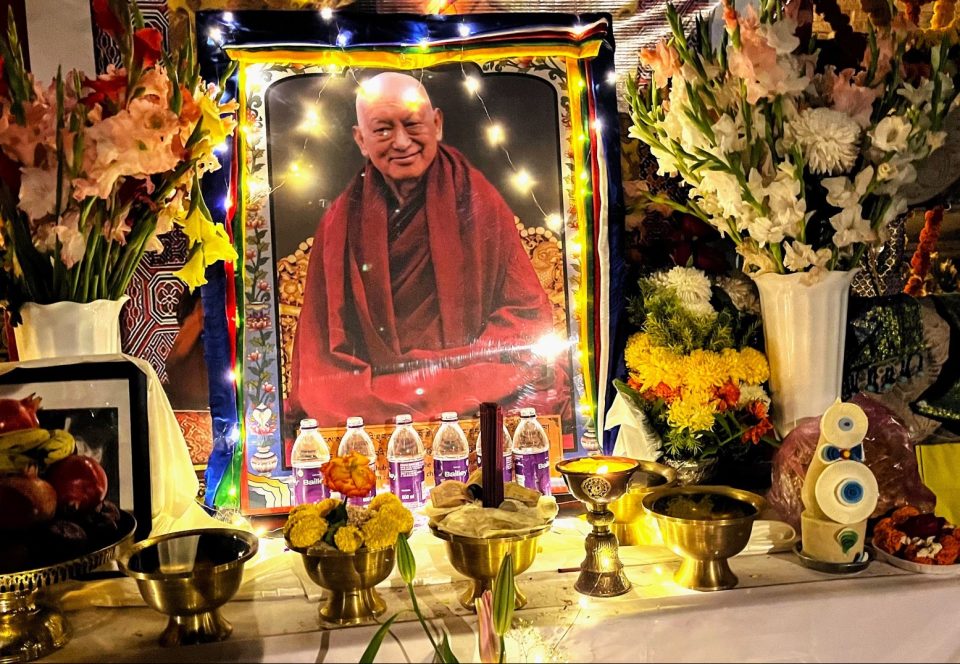
Altar of Lama Zopa Rinpoche in Bodhgaya, December 31, 2023. Photo by Ven. Tenzin Michael.
In October 2023 we shared the very precious advice we received from His Holiness the Dalai Lama to recite Chanting the Names of Noble Manjushri continuously for a few months, for the swift return of Lama Zopa Rinpoche’s reincarnation.
We wanted to take the opportunity to remind students of this advice, particularly with Losar and the Fifteen Days of Miracles approaching when the merit of virtuous actions performed on each of these days is multiplied by 100 million.
We are pleased to share that Ganden Tri Rinpoche, head of the Gelug school of Tibetan Buddhism and very close to Lama Zopa Rinpoche, will be offering the transmission of Chanting the Names of Noble Manjushri on February 17, 2024 through Jamyang Buddhist Centre London and this will be available online for all with interest to join.
As a reminder, IMI has arranged continual recitations of this text for Rinpoche’s swift return by students around the world in all the various time zones! Please read about how to sign up to join.
Chanting the Names of Noble Manjushri Materials
The prayer is available for all to download: Chanting the Names of Noble Manjushri.
Additionally, Lama Yeshe Wisdom Archive also offers Lama Zopa Rinpoche’s own commentary and oral transmission of Chanting the Names of Noble Manjushri which is available to all.
Foundation for the Preservation of Mahayana Tradition (FPMT), is a Tibetan Buddhist organization dedicated to the transmission of the Mahayana Buddhist tradition and values worldwide through teaching, meditation and community service.
- Tagged: chanting the names of manjushri
30
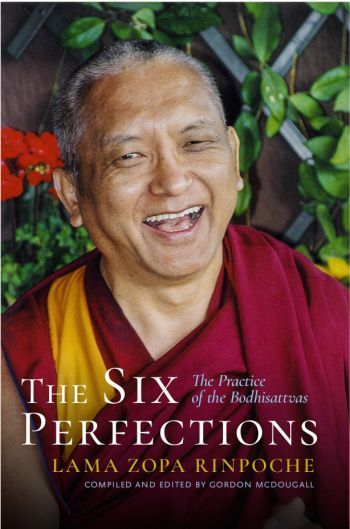
In The Six Perfections: The Practice of the Bodhisattvas (2020), Lama Zopa Rinpoche walks us through the six perfections, which are a key Mahayana Buddhist teaching.
Today we share an excerpt from Rinpoche’s teaching on the perfection of charity from this book, available from Wisdom Publications:
Keeping our mind pure—free from pride, miserliness, and so forth—is very difficult for ordinary people like us. If we could give simply, without all these disturbing thoughts clouding our giving, our generosity would be perfect and attaining another perfect human rebirth would be easy. But this is a struggle for most of us. That is why we must always check our motivation and be diligent in observing our karma.
The villagers of Solu Khumbu, where I was born, have a very good custom to protect themselves and others. Because they are incredibly poor, theft is always a problem. Things are often stolen: cooking pots, money—even potatoes. In many villages the people bury pots of their precious potatoes outside to keep them safe, but thieves can generally guess where the pots are buried, and they dig them up. Also, sometimes people borrow things and don’t return them, no matter how much the owner complains and shouts.
In such cases of theft, the villagers often go to a monastery and ask the lama there to say prayers and dedicate the merit of the prayer to the thief, totally offering them that thing. Whether or not this becomes a virtuous act does not depend on the lama but on the mind of the victim. If the person can renounce the stolen object completely and offer it to the thief with compassion, then it is virtuous. The owner needs the object, but the thief also needs it, and so by renouncing it and offering it to the thief with compassion, the dedication becomes a virtuous action.
If somebody stole a hundred dollars from us and we cannot do the practice of dedication—if we cannot take the loss upon ourselves and offer the victory to that sentient being; if we still cling to that hundred dollars—how can we perfect the practice of charity? Even without considering how kind that sentient being has been, how precious they are, we should rejoice that they needed something and now they have it. Like us, they want happiness and do not want suffering—in that way they are completely equal to us—so why can’t they have that hundred dollars? If we were to find a hundred dollars, how happy we would be. If we were to find a thousand dollars or a million dollars, we would be so surprised and excited. We would clap our hands with joy. So why can’t we do the same thing for this sentient being who has come across a hundred dollars?
Excerpted from Chapter 1, The Six Perfections: The Practice of the Bodhisattvas, Wisdom Publications, 2020.
Explore more teachings on the six perfections from Lama Zopa Rinpoche including other excerpts from this book.
Learn more about The Six Perfections: The Practice of the Bodhisattvas, including order information, on Wisdom Publication’s website:
https://wisdomexperience.org/product/the-six-perfections/
The Six Perfections is also available as an e-book from the Foundation Store.
Lama Zopa Rinpoche (1945-2023) was the spiritual director of the Foundation for the Preservation of Mahayana Tradition (FPMT), a Tibetan Buddhist organization dedicated to the transmission of the Mahayana Buddhist tradition and values worldwide through teaching, meditation and community service.
- Tagged: six perfections
26
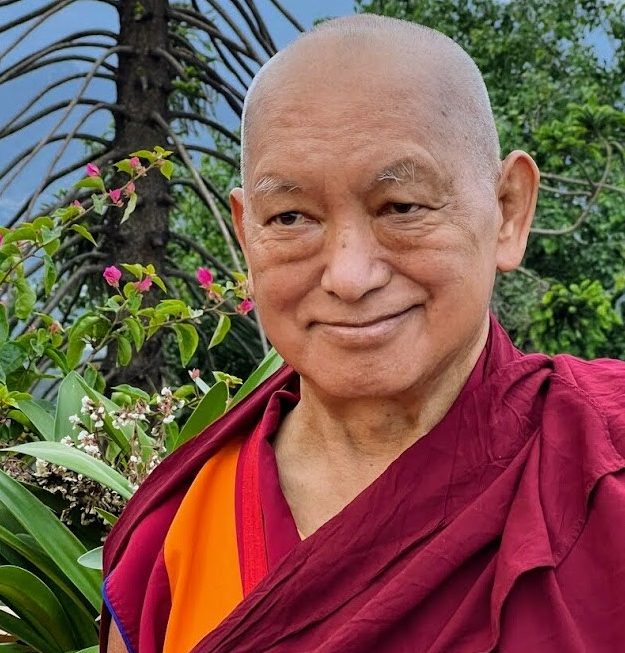
Lama Zopa Rinpoche in the garden at Kopan Monastery, Nepal, 2022. Photo by Ven. Roger Kunsang.
In a 2022 letter to an FPMT center director, Lama Zopa Rinpoche, the perfect epitome of patience, offered an unmissable teaching on why patience is critically important, and how to protect and cultivate it through applying conscientious effort. Explaining the value of patience, Rinpoche said it protects our hard-won merits, which are necessary for our liberation from samsara but which are easily destroyed through our acts of anger and heresy.
Rinpoche then advised on how best to dedicate our merits so as to protect them. Rinpoche’s letter also offers guidance on six ways to train the mind in patience: by seeing the “enemy” as the guru and as positive support, by realizing that the “enemy” has no freedom to act differently, by developing compassion, and by remembering karma and the emptiness of phenomena.
We offered a short edited version of this advice in our 2022 Annual Review, and now we are very happy to share this entire advice available as a PDF download.
Please explore other teachings from Lama Zopa Rinpoche on the topic of patience.
You can read other advice that Lama Zopa Rinpoche has offered students on the topic of patience and anger.
Order Lama Zopa Rinpoche’s book, Patience: A Guide to Shantideva’s Sixth Chapter from Wisdom Publications.
Lama Zopa Rinpoche (1945–2023) was the spiritual director of the Foundation for the Preservation of Mahayana Tradition (FPMT), a Tibetan Buddhist organization dedicated to the transmission of the Mahayana Buddhist tradition and values worldwide through teaching, meditation and community service.
- Home
- News/Media
- Study & Practice
- About FPMT Education Services
- Latest News
- Programs
- New to Buddhism?
- Buddhist Mind Science: Activating Your Potential
- Heart Advice for Death and Dying
- Discovering Buddhism
- Living in the Path
- Exploring Buddhism
- FPMT Basic Program
- FPMT Masters Program
- FPMT In-Depth Meditation Training
- Maitripa College
- Lotsawa Rinchen Zangpo Translator Program
- Universal Education for Compassion & Wisdom
- Online Learning Center
- Prayers & Practice Materials
- Overview of Prayers & Practices
- Full Catalogue of Prayers & Practice Materials
- Explore Popular Topics
- Benefiting Animals
- Chenrezig Resources
- Death & Dying Resources
- Lama Chopa (Guru Puja)
- Lama Zopa Rinpoche: Compendium of Precious Instructions
- Lama Zopa Rinpoche: Life Practice Advice
- Lama Zopa Rinpoche Practice Series
- Lamrim Resources
- Mantras
- Prayer Book Updates
- Purification Practices
- Sutras
- Thought Transformation (Lojong)
- Audio Materials
- Dharma Dates – Tibetan Calendar
- Translation Services
- Publishing Services
- Teachings and Advice
- Find Teachings and Advice
- Lama Zopa Rinpoche Advice Page
- Lama Zopa Rinpoche: Compendium of Precious Instructions
- Lama Zopa Rinpoche Video Teachings
- ༧སྐྱབས་རྗེ་བཟོད་པ་རིན་པོ་ཆེ་མཆོག་ནས་སྩལ་བའི་བཀའ་སློབ་བརྙན་འཕྲིན།
- Podcasts
- Lama Yeshe Wisdom Archive
- Buddhism FAQ
- Dharma for Young People
- Resources on Holy Objects
- Ways to Offer Support
- Centers
- Affiliates Area
- Teachers
- Projects
- Charitable Projects
- Make a Donation
- Applying for Grants
- News about Projects
- Other Projects within FPMT
- Support International Office
- Projects Photo Galleries
- Give Where Most Needed
- FPMT
- Shop
Translate*
*powered by Google TranslateTranslation of pages on fpmt.org is performed by Google Translate, a third party service which FPMT has no control over. The service provides automated computer translations that are only an approximation of the websites' original content. The translations should not be considered exact and only used as a rough guide.Once you realize the true evolution of your mental problems, you’ll never blame any other living being for how you feel.







